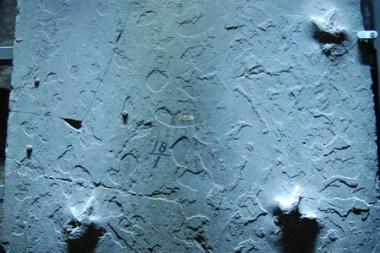It’s strange, but when people think “dinosaur,” the Connecticut River Valley rarely rates high on anyone’s list.
Still, while several locations across the globe boast productive dinosaur bone fields where paleontologists have exhumed skeletons, no where on Earth can boast the number of fossilized tracks that have been found in our Valley. For hundreds of years, residents along the river have been having close encounters with these prehistoric creatures through the impressions they left behind in the hardened mud.
When Pliny Moody, a young farmer in South Hadley, found a slab of rock with a set of three-toed footprints in 1802, he took it to a local church minister, who declared it Biblical evidence. Here—set in stone like Moses’ 10-commandments—were tracks left by the raven Noah released during the flood but which never returned to him. Content with his curiosity, Moody used the slab as his front doorstep.
Laying slate in the sidewalks of Greenfield in 1835, Dexter Marsh also came across footprints in the rock. Unlike Moody, he wanted more fossils to study and a better understanding of where they came from. He built himself a flat-bottom boat and began traveling the river, looking for more samples, and over the years, he accumulated a large collection he displayed in a museum near where the current Hope and Olive restaurant stands. He was elected to the American Association for the Advancement of Science and is considered one of the first American paleontologists. Upon his death, his collection was sold to several New England universities.
Hearing about Moody’s rock and the tracks found in Greenfield, Amherst College geology professor Edward Hitchcock also began researching and collecting tracks in 1835. He debated their origins with Darwin, and he objected when his European colleagues coined the name “dinosaur.” He argued that the impressions appeared to be more avian than reptilian, and though dismissed then, his reasoning has been recently revisited, and, in some cases, adopted.
Tim Neumann is the Executive Director of the Pocumtuck Valley Memorial Association (PVMA), a history museum located in Deerfield and housed in Memorial Hall—the building where Hitchcock taught before getting a job at Amherst College. Neumann has long hoped to return the Connecticut River valley to its rightful place at the top of people’s lists when learning more about our prehistoric past.
The Jurassic Roadshow is one such initiative that he hopes “will draw a new audience.”
On Saturday, Aug. 28, from 11 a.m. to 3 p.m. at the Great Falls Discovery Center in Turners Falls, fossils of all kinds will be on display—footprints, fish, trilobites, raindrop impressions—including samples from the private collections of two area collectors. To help understand the science behind the fossils, a paleontologist and geologist will be on hand. Residents are also invited to bring their own rocks or fossils for identification (they don’t need to be from the Jurassic era), and there will be a booth devoted to preserving local stories related to area fossils and fossil hunters.



